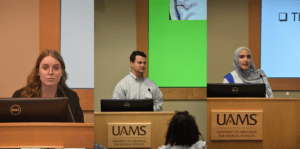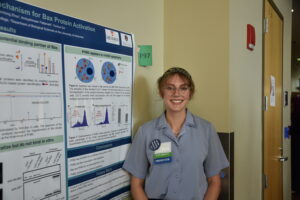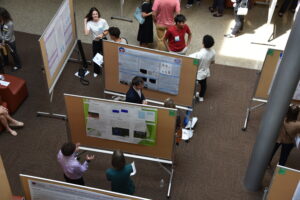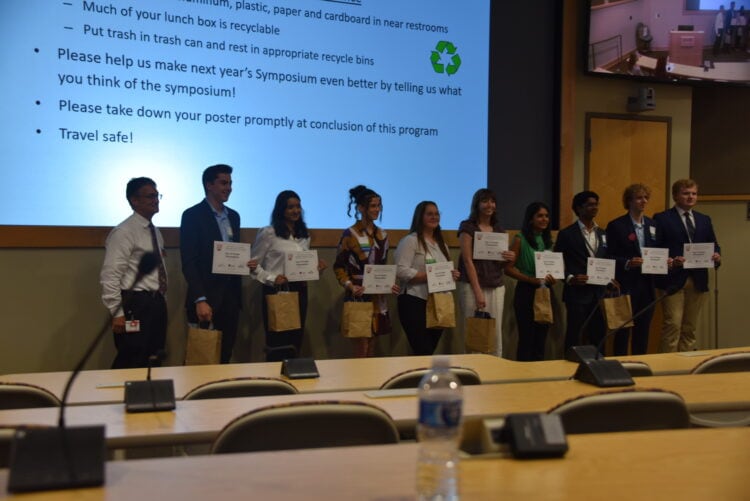View Larger Image
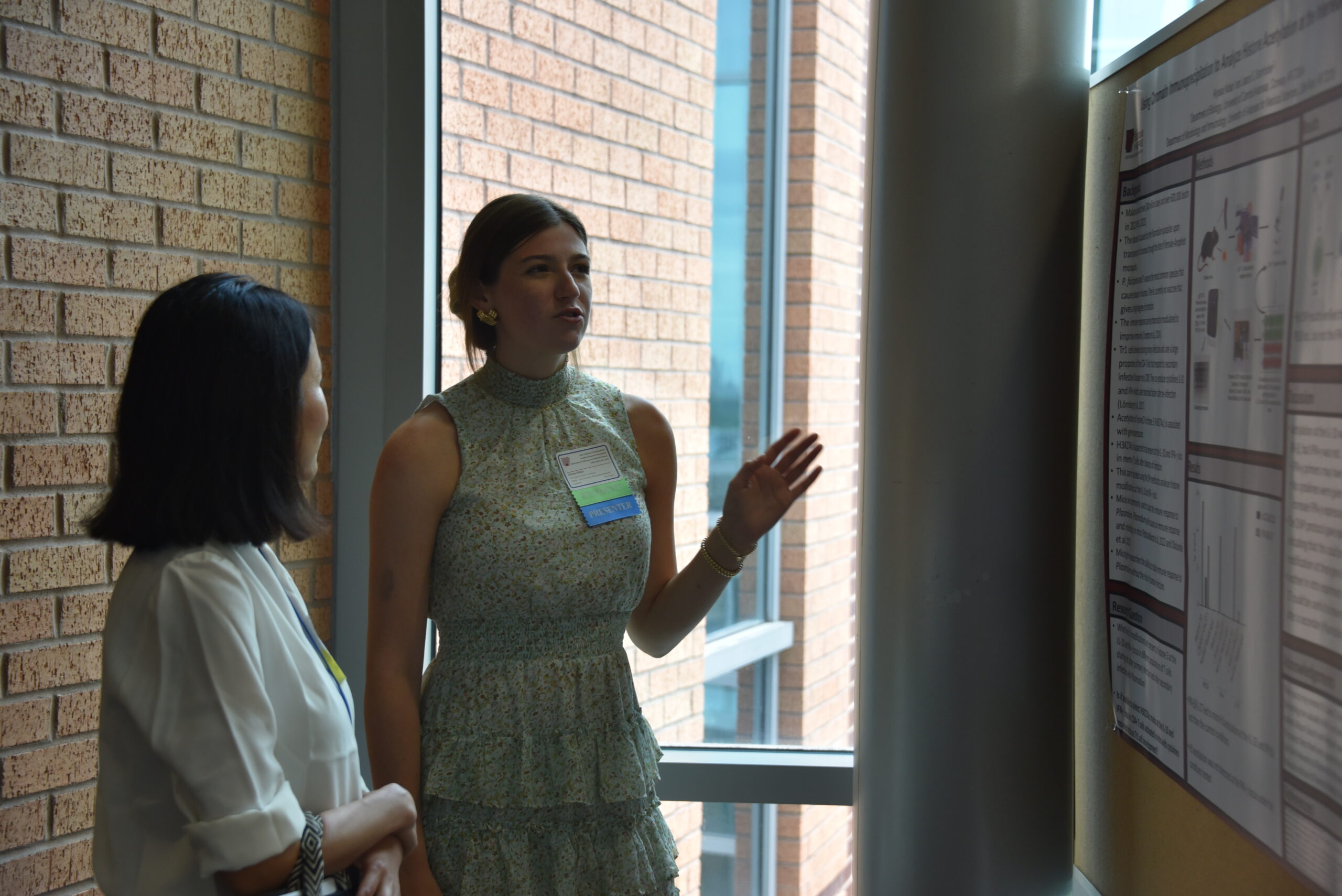
Alyssa Nolan of the University of Central Arkansas and the INBRE program explains her poster.
Image by Nathan Tidwell
Undergraduates Show Off Research Skills at UAMS’ Summer Symposium
| The University of Arkansas for Medical Sciences (UAMS) hosted students from 39 colleges and universities across the nation at the 11th Annual Arkansas Undergraduate Summer Research Symposium.
The symposium was an opportunity for undergraduate students to present research on a wide range of topics including biomedical sciences, plant science. informatics and modeling. The UAMS College of Medicine Department of Biochemistry and Molecular Biology organized and sponsored the event with support from the UAMS Graduate School and the IDeA Networks of Biomedical Research Excellence (INBRE) program.
UAMS Chancellor Cam Patterson, M.D., MBA, welcomed the attendees to kick start the event.
“This symposium stands as a testament to the curiosity, dedication and ingenuity of students, who have embarked on journeys of exploration within their respective fields. Undergraduate research is not merely a supplement to coursework; it is a transformative experience that nurtures critical thinking, problem-solving skills and a deeper understanding of academic disciplines.”
“We have students doing great work not just at UAMS but across the state,” said Grover Paul Miller, Ph.D., a professor in the Department of Biochemistry and Molecular Biology and the organizer of the symposium. “We want to honor student achievements and for them to think about careers in science.”
The event was held July 24 at the I. Dodd Wilson Education Building and backed by grant funding from the National Institute of General Medical Sciences. More than 125 student researchers were registered, and more than 100 faculty and administrators provided support for the symposium.
“Research is very interactive, and that’s what we’re looking to replicate at this symposium,” said Miller.
Undergraduate and high school students participated in 16 different research programs in colleges and universities, many independent research programs, as well as the U.S. Food & Drug Administration’s National Center for Toxicological Research (NCTR) near Pine Bluff.
Lawrence Cornett, Ph.D., a distinguished professor in the College of Medicine Department of Physiology and Cell Biology and the director of the INBRE program, talked about how the symposium benefits not only the students but also UAMS.
“A large percentage of these students will end up at UAMS,” Cornett said. “Going through research programs and learning to present makes them better students for us.”
The following students were selected from a competition to give oral presentations, which were divided into morning and afternoon sessions chaired by Katie Ryan, Ph.D., an assistant professor in the Department of Biochemistry and Molecular Biology, and Alicia Byrd, Ph.D., an assistant professor in the department. The research program is listed in parentheses:
• Nyera Ali, Pulaski Academy High School (Summer Research Internship program)
• Samuel Chesshir, Harding University (INBRE National Resource for Quantitative Proteomics Internship Program)
• Harrison Cook, University of Mississippi (INBRE)
• Neil Dogra, Hendrix College (NCTR Summer Student Research Program)
• Allie Farrar, Hendrix College (INBRE)
• Andrew Hamilton, University of Arkansas at Fayetteville (professional research opportunity)
• Rutu Mahajan, Arkansas State University (independent study)
• Madison Purifoy, University of Arkansas at Pine Bluff (Connect Arkansas Research Scholars)
• John Schaller, Hendrix College (INBRE)
• Faith Stephens, Arkansas State University (Summer Undergraduate Research Fellowship, UAMS Department of Biochemistry and Molecular Biology)
• Sofia Syed, Hendrix College (Summer Research Internship program)
• Demah Yousef, Hendrix College (Summer Undergraduate Research Fellowship, UAMS Department of Pharmacology and Toxicology)
These 12 students were selected out of 53 submissions. Each student was given 12 minutes for their presentation, followed by three minutes for questions.
Ali, one of several high school students participating in the symposium, discussed her research on the need to develop a blood test for drug-induced liver injury.
“The current method for testing lacks specificity, and drugs usually are unnecessarily removed from the market,” said Ali.
Chesshir explained how the National Resource for Quantitative Proteomics helps with research.
“They provide state-of-the-art quantitative proteomics at a low cost to underfunded states,” he said. “They also provide different outreach and internship opportunities.”
Cook discussed how endothelial cells, which line all blood vessels and regulate exchanges between the bloodstream and the surrounding tissues, relate to intestinal organoid growth.
“We found that these cells play a role in improving the integrity and function of the intestinal tract,” Cook said.
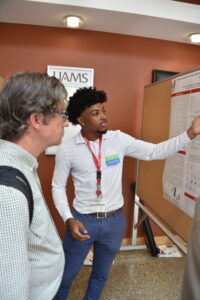
Carvis Campbell III of the University of Arkansas at Pine Bluff and the Connect Arkansas Research Scholars program discusses his poster.Image by Nathan Tidwell
Morning and afternoon poster sessions also gave students a chance to discuss their research with faculty, guests, mentors and peers.
Megan Gray of Hendrix College worked with the Arkansas Children’s Hospital’s Summer Science Program on the use of artificial intelligence in developing film-based curriculum for the core competencies required by medical students for graduation.
“We pulled scenes from medical shows that represented these competencies,” she said. “Right now, medical schools are using exams and simulations, which are resource intensive. We found that AI is limited as most systems wanted to either generate a video or create a script based on the video.”
Alekhya Kavi of the University of Arkansas at Fayetteville and the Summer Undergraduate Research Fellowship program studied the effects of restricting methionine, an amino acid, in the diet of mice as it relates to colorectal cancer.
“Colorectal cancer tumors were inserted into mice, and one of two diets were randomly assigned to them,” said Kavi. “We found different results with male and female mice based on the modification of the DNA.”
Caleb Miller, a student at Ouachita Baptist University, researched the histology of zebrafish.
“In high-stress lab environments zebrafish offspring often have a skewed ratio of females to males,” Miller said. “We were able to implement histology procedures that will help us see what we’re looking for in larval-stage development.”
Emma Riordan from Hendrix College was part of INBRE and investigated whether certain genes are an underlying cause of diabetes.
“We were looking at whether there are genes that are only activated under certain environmental conditions,” said Riordan, who completed her program at the University of Arkansas at Fayetteville. “UAMS helped a lot with this project.”
Guest speaker Christina Cooley, Ph.D., an associate professor of chemistry at Trinity University in San Antonio, gave a talk titled “Full Circle: My Journey from Performing Undergraduate Research to Leading an Undergraduate Research Lab.”
The Conway native worked as a research assistant at UAMS before earning her bachelor’s degree in chemistry from Hendrix College and her doctorate in organic chemistry from Stanford University.
“It’s impressive to see all of the awesome science going on here,” Cooley said. “It makes me really excited for the future.”
Mohammad Rahman, Ph.D., an assistant professor in the Department of Biochemistry and Molecular Biology, announced awards for the following 10 students for top poster presentations from a stiff competition among 122 poster presentations. The following students achieved that recognition (research program listed in parentheses):
- Ian Blair, University of Central Arkansas (Undergraduate Research, UCA Department of Chemistry & Biochemistry)
- Anna Bolding, University of Arkansas at Fayetteville (Summer Undergraduate Research Fellowship, UAMS Department of Biochemistry and Molecular Biology)
- Abhishu Chand, Missouri State University (Missouri State University)
- Dallas Fuller, Harding University (INBRE)
- Braden Glenn, Lyon College (INBRE)
- Liz Hicklin, University of Central Arkansas (Summer Undergraduate Research Fellowship, UAMS Department of Biochemistry and Molecular Biology)
- Alekhya Kavi, University of Arkansas at Fayetteville (Summer Undergraduate Research Fellowship, UAMS Department of Pharmacology and Toxicology)
- Reha Nunna, University of Arkansas at Fayetteville (NCTR Summer Student Research Program)
- Emily Sevor, Arkansas State University (INBRE)
- Siddarth Sridharan, Little Rock Central High School (Summer Research Internship program)
“These were selected from 122 posters, which is quite an accomplishment,” said Miller.
After recognizing the top student presenters, Luke Robins from Ouachita Baptist University was chosen from a raffle to win a door prize, a Galileo thermometer with glass globe barometer, provided by the Central Arkansas Chapter of Sigma Xi, a science research honor organization. Miller then closed the event thanking the many volunteers from UAMS and participating institutions who made the event possible along with funding support, especially from INBRE, so that the event was free for everyone to enjoy.


